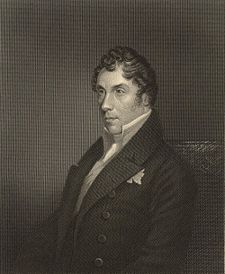George Hamilton Gordon 4th Earl of Aberdeen 1784 – 1860
December 14, 2008
 George
Hamilton
Gordon
4th Earl of Aberdeen
KG
KT
FRS
PC
1784 – 1860 styled Lord Haddo from 1791 to 1801, was a Scottish
politician, successively a Tory, Conservative and Peelite, who served as
Prime Minister of the United
Kingdom
from 1852 until 1855.
George
Hamilton
Gordon
4th Earl of Aberdeen
KG
KT
FRS
PC
1784 – 1860 styled Lord Haddo from 1791 to 1801, was a Scottish
politician, successively a Tory, Conservative and Peelite, who served as
Prime Minister of the United
Kingdom
from 1852 until 1855.
George Hamilton Gordon was an advocate of homeopathy, and he was a patient of James Manby Gully, who he described as the ‘… most gifted physician of the Age…‘.
George Hamilton Gordon was a friend of William Gladstone, Francois Pierre Guillaume Guizot and Robert Peel.
Born in Edinburgh on 28 January 1784, George Hamilton Gordon was the eldest son of George Gordon, Lord Haddo, son of George Gordon, 3rd Earl of Aberdeen. His mother was Charlotte, daughter of William Baird. He lost his father in 1791 and his mother in 1795 and was brought up by Henry Dundas, 1st Viscount Melville.
He was educated at Harrow, and St John’s College, Cambridge, where he graduated with an MA in 1804. Before this, however, he had become Earl of Aberdeen on his grandfather’s death in 1801, and had travelled all over Europe. On his return to England, he founded the Athenian Society.
In 1805, he married Lady Catherine Elizabeth, daughter of John Hamilton 1st Marquess of Abercorn. In December he took his seat as a Tory Scottish representative peer in the House of Lords. In 1808, he was created a Knight of the Thistle.
Following the death of his wife in 1812 he joined the Foreign Service. He was appointed ambassador extraordinary and minister plenipotentiary at Vienna, where he signed the Treaty of Töplitz between Britain and Austria in October 1813.
He was one of the British representatives at the Congress of Chatillon in February 1814, and at the negotiations which led to the Treaty of Paris in May of that year.
Returning home he was created a peer of the United Kingdom as Viscount Gordon, of Aberdeen in the County of Aberdeen (1814), and made a member of the Privy Council. In July 1815 he married Harriet, daughter of John Douglas, and widow of James, Viscount Hamilton. During the ensuing thirteen years Aberdeen took a less prominent part in public affairs.
He served as Chancellor of the Duchy of Lancaster (1828) and Foreign Secretary (1828-30) under Arthur Wellesley 1st Duke of Wellington. He resigned with Arthur Wellesley 1st Duke of Wellington over the Reform Bill of 1832.
He was Secretary of State for War and the Colonies (1834-35) and then Foreign Secretary (1841-46) under Robert Peel. It was during his second stint as Foreign Secretary that he settled two disagreements with the US - the Northeast Boundary dispute by the Webster-Ashburton Treaty (1842), and the Oregon dispute by the Oregon Treaty of 1846.
He also worked successfully to improve relationships with France, where Francois Pierre Guillaume Guizot had become a personal friend. He again followed his leader and resigned with Robert Peel over the issue of the Corn Laws.
After Robert Peel’s death in 1850 he became the recognized leader of the Peelites. His dislike of the Ecclesiastical Titles Assumption Bill, the rejection of which he failed to secure in 1851, prevented him from joining the government of Lord John Russell.
In December 1852, however, he became Prime Minister and headed a coalition ministry of Whigs and Peelites. Although united on free trade and on questions of domestic reform, his cabinet which contained Henry Palmerston and Lord John Russell, was certain to differ on questions of foreign policy.
He entered the country into the Crimean War on the side of the Ottoman Empire following pressure from some of his cabinet. Henry Palmerston, supported by Lord John Russell, favoured a more aggressive policy, and Aberdeen, unable to control Henry Palmerston, acquiesced.
However the war proved his downfall. As reports returned detailing the mismanagement of the conflict Lord John Russelll resigned; and on 29 January 1855 a motion for the appointment of a select committee to enquire into the conduct of the war, was carried by a large majority. Treating this as a vote of no confidence, Aberdeen resigned.
Lord Aberdeen died at Argyll House, St. James’s, London on 14 December 1860, and was buried in the family vault at Stanmore.